Bibliography
References and suggestions for further reading* The search for background literature was in this case a little difficult. Many people have experienced the changes in Latvia in different fields and in a corresponding way as we have. Therefore, many publications cover basically the same, but with different penetration and with different time spans of observation, according to the year of printing. Among the works we have had in our hands, almost all of them have been directly cited in the text, but we have also included some more general texts which showed to be useful..
Aage H. Environmental transition on Nordic and Baltic countries. Cheltenham UK/ Northampton, MA, USA: Elgar, 1998.
Aarsæther N. Reflections on health and democracy – proposals for interdisciplinary projects. Michael 2004; 1: 221–30.
Aasland A (ed.) Latvia: The impact of the transformation. Fafo report 188. Oslo: Forskningsstiftelsen Fafo, 1996.
Aasland A, Tyldum G. Better or worse? Living Conditions Development in Estonia, Latvia and Lithuania 1994–1999. Oslo: Fafo Institute for Applied Social Science, 2000.
Apinis P. Latvia: Country, nation, state. (Riga): Nacionalais Medicinas Apgads, (undated).
Baister S, Patricki C. Latvia – the Bradt travel guide. Third edition. Chalfont St. Peter/Guilford, Connecticut: Bradt Travel Guides Ltd/The Globe Pequot Press Inc.: 2002.
Bakke E. (red.) Sentral-Europa og Baltikum etter 1989. Oslo: Det norske samlaget, 2002.
Blakkisrud H. De russiske minoritetene i Estland og Latvia. (The Russian minorities in Estonia and Latvia. Thesis for a major in political science). Oslo: Norwegian Institute of International Affairs, 1995.
Blane D, Brunner E, Wilkinson R. (eds.). Health and social organization. London/New York: Routledge, 1996.
Blystad H, Blad L, Tulisov A, Aavitsland P. Status on some important infectious diseases in Northwest Russia and the Nordic and Baltic countries 1999–2003. EpiNorth 2004/2005; Vol. 5/6, No 4/1, 1–32.
Cockerham WC. Health and social change in Russia and Eastern Europe. New York/London: Routledge, 1999.
Dreifelds J. Latvia in transition. Cambridge: Cambridge University Press, 1996.
Eglitis DS. Imaging the nation. History, modernity, and revolution in Latvia. University Park: The Pennsylvania State University Press, 2002.
Evang K. Health service, society, and medicine: present day health services in their relation to medical science and social structures. (Heath Clark lectures 1958). London: University of London 1960.
Fainsod M. How Russia is ruled. Revised edition. Cambridge Ma.: Harvard University Press, 1967.
Hall CM. Tourism: Rethinking the social science of mobility. Prentice Hall: Harlow etc., 2005.
Grønningsæter A. Great Expectations. Social exclusion and social policy in Estonia and Latvia. Oslo: Fafo Institute for Applied Social Science, 2003. Fafo-report 410.
Hall DR (ed.) Tourism and Economic Development in Eastern Europe and the Soviet Union. London: Belhaven Press etc., 1991.
Harjula M. Sick Finland? – The crisis of Finnish health policy in the 1960s. Michael 2004 ; 1: 287–99.
Hasler T. «Her er mitt hjem» – Russere i Latvia. («Here is my home» – Russians in Latvia. Thesis for a major in social anthropology). Oslo: Institute and museum for anthropology University of Oslo, 1996.
Health care systems in transition – Latvia. Copenhagen: The European Observatory on Health Care Systems. WHO Regional Office for Europe. 2001.
Health in Latvia. Year-book of Latvian Health Statistics 1990. I. edition. Riga 1991.
Hendel S. The Soviet crucible. Second edition. Toronto/New York/London: D. van Nostrand company Inc., 1963.
Hewitt M. Oppgjøret med kommunistfortiden. En komparativ studie av Estland, Latvia og Litauen. Oslo: Institutt for statsvitenskap, Universitetet i Oslo, 2002.
Holst F. Betragtninger over de nyere Britiske Fængsler: især med Hensyn til Nødvendigheden af en Forbedring I Fangepleien I Norge. Christiania: Lehmann 1823.
Hønneland G, Rowe L. Health as international politics. Combating communicable diseases in the Baltic Sea region. Aldershot: Ashgate, 2004.
Kanep VV, Popov GS, Solomonov SL, Iablonskaja LF, Magid MB. (Microcomputer-based automated registry of the KASMON system (comprehensive automated system of medical examinations of the population)) (Article in Russian) Sov Zdravookhr. 1988; (1): 32–6.
Kilkuts G, Larsen Ø, Rosvold EO. Health and social change in Latvia 1991–2001 – a modern piece of medical history. Michael 2004:1; 277–85.
Kilkuts G, Rosvold EO, Straand J, Larsen Ø. Risk perception of communicable diseases among adult Latvian general practice patients. Michael 2005; 2: 211–7.
Kilkuts G, Rosvold EO, Straand J, Lindbæk M, Larsen Ø. Seeing a general practitioner in Latvia and Norway – a comparative study. Michael 2005; 2: 200–10.
Klavina K. Park og hageanlegg I Rigas sentrum (Parks and gardens in central Riga. Thesis for a major at the Institute of landscape planning). Ås: Norwegian University of Life Sciences, 2002.
Lancmanis I. Rundale. Riga: Jumala, 2001.
Larsen Ø. Epidemic diseases in Norway in a period of change. Oslo: Unipub, 2000.
Larsen Ø. En ny type kvinnesak. Tidsskr Nor Lægeforen 1999;119:1409–10.
Larsen Ø. Exploring external and internal public health concepts. Michael 2004; 1: 193–205.
Larsen Ø. Health care and attitudes in health matters – some personal reflections. (Braga lecture 2004, paper in press 2005.)
Larsen Ø. Kirurgiske resultater fra 1860-årene – krigskirurgi stadig aktuelt. Tidsskr Nor Lægeforen 1991;111:657–9.
Larsen Ø. Metodeproblemer i medisinsk historie. Nordisk Medicin 1968; 80: 1237–42.
Larsen Ø. På sporet av rigabalsam. Tidsskr Nor Lægeforen 1993; 113: 3775–7.
Leifman H, Henrichson N E. (eds.) Statistics on alcohol, drugs and crime in the Baltic Sea region. NAD Publication No. 37. Helsinki: Nordic Council for Alcohol and Drug Research, 2000.
Lieven A. The Baltic revolution. Estonia, Latvia, Lithuania and the path to independence. 2nd. ed. New Haven and London: Yale University Press, 1994.
Loza Z, Aasland A. From a local perspective: Social assistance and social work in Latvia. Oslo: Fafo, Institute for Applied Social Science. Fafo-paper 2002–2.
MacCannel D. The tourist. A new theory of the leisure class. New York: Schocken Books, 1976, revised edition 1989.
Maslow A. Motivation and personality. New York: Harper & Brothers, 1954.
Mittelmark MB New objectives in public health: Health promotion and the research methods in social sciences. Michael 2004; 1: 212–20.
Natvig H. Lærebok i hygiene. Oslo: Liv og Helses forlag, 1958.
Nørgaard O, Johannsen L, Skak M, Sørensen RH. The Baltic states after independence. Second edition. Cheltenham, UK/Northampton, MA, US, 1999.
Nørgaard O. (red.) De baltiske lande efter uafhengigheden. Hvorfor så forskellige? Århus: Politica, 1994.
Paldam M. Udviklingen I Rusland, Polen og Baltikum. Århus: Aarhus Universitetsforlag, 2002.
Plakans A. The Latvians. A short history. Stanford Ca.: Hoover Institution Press, 1995.
Rupeiks E, Johansen A. The European Union Pre-Structural Funding Programme SAPARD as a Development Instrument for Rural Tourism Entrepreneurs in Latvia. Stavanger: Norwegian School of Hotel Management, Stavanger University College, 2004.
Siem H. International health collaboration: The case of the Task Force on Communicable Disease in the Baltic Sea Region. In: Tellnes G. (ed.) Urbanization and health. New challenges to health promotion and prevention. Oslo: Unipub 2005.
Siem H. Task Force on communicable disease control in the Baltic Sea region. Michael 2004; 1: 315–9.
Sontag S. On photography. London: Penguin 2002.
Steen A (ed.). Ethnicity and politics in Estonia, Latvia and Lithuania. Oslo: Department of political science, University of Oslo, 1997.
Tellnes G. The community approach to public health. Michael 2004; 1: 206–11.
The Baltic and the Nordic countries. Riga: Central Statistical Bureau of Latvia, 2000.
Wilkinson RG, Unhealthy societies – The afflictions of inequality. London and New York: Routledge, 1996.
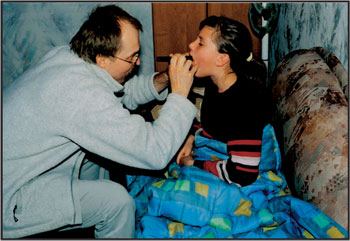
Riga house call 2004: The doctor seeing a 12 year old girl with a sore throat.
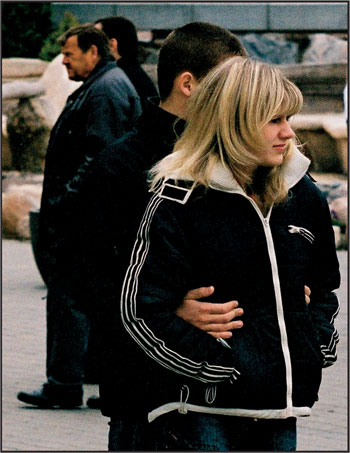
Love is in the air in modern Latvia (2005).
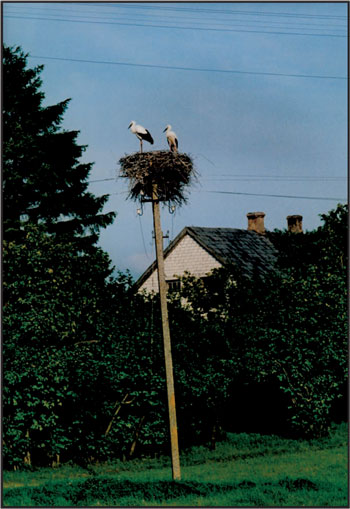
Storks doing a bad job for Latvian demography (1993).
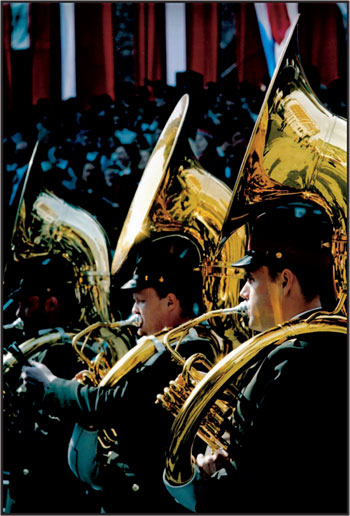
Riga, May 1, 2004: The transition period since the Soviet Union is over and hornists celebrate the entrance into the European Union.
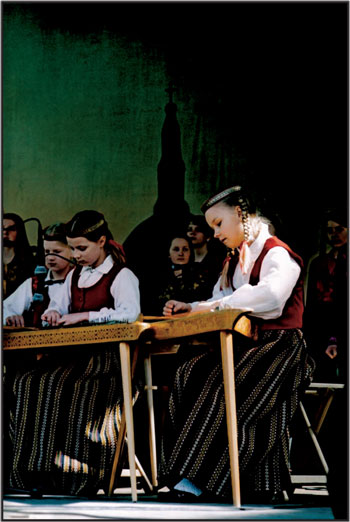
Riga, May 1, 2004: Children string players with no personal memories of the Soviet Union also contribute to the celebration.
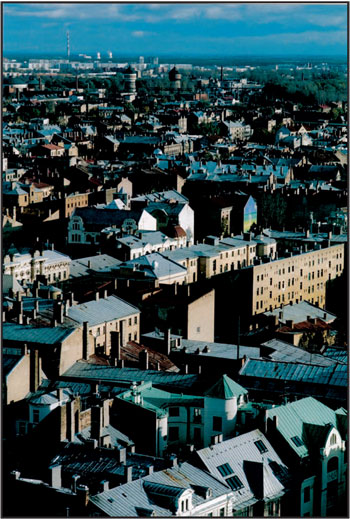
Riga roofs 2003.
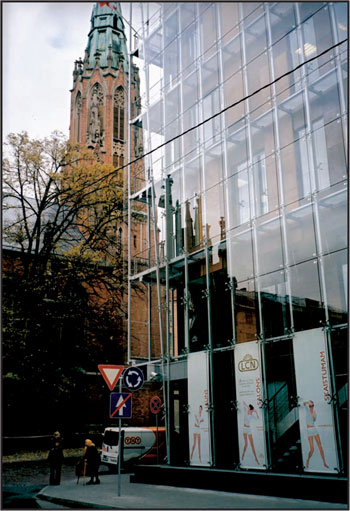
Contrasts at Gertrudes’ church, Riga 2003.
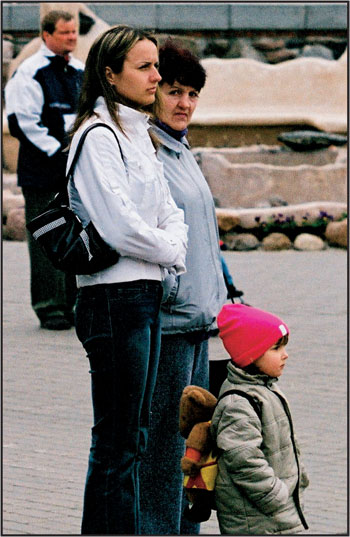
Sceptical Latvians 2005?
